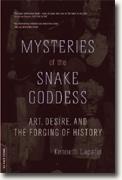Kenneth Lapatin
book reviews:
· general fiction
· chick lit/romance
· sci-fi/fantasy
· graphic novels
· nonfiction
· audio books
· author interviews
· children's books @
curledupkids.com
· DVD reviews @
curledupdvd.com
newsletter
win books
buy online
links
home
for authors
& publishers
for reviewers

 |
Mysteries of the Snake Goddess: Art, Desire, and the Forging of History Kenneth Lapatin DaCapo Press Paperback 288 pages December 2003 |
|
The Minoan Snake Goddess, a statuette composed of ivory and gold, called chryselephantine, has graced the covers of not only the Museum of Fine Arts in Boston’s brochures and advertising, but fashion magazines, articles, and newspapers since Mrs. W. Scott Fitz gave her to the museum at the end of 1914. Americans, who had not entered the war raging in Europe, fell in love with the bare-breasted female snake handler who it was reported came from the archaeological dig funded and managed by Sir Arthur Evans on Crete where he was uncovering the remains of the great Minoan civilization that the Mediterranean 5,000 years before it was rediscovered in 1900. Now called the Boston Goddess, the statuette has been called “the most refined and precious object to have survived the ruin of Minoan civilization” and has been mythologized as a perfect example of art in its highest and most modern seeming form.
Kenneth Lapatin traces the Boston Goddess’s history from her supposed discovery in a temple repository beneath the throne room floor in the palace of Knossos until she emerged in Boston in Mrs. Fitz’s possession and was turned over to the Museum of Fine Arts in Boston to take center stage in their Classical art wing among Etruscan, Greek and Roman artifacts. Lapatin’s proof is contained not only in anecdotal tales, some of which he thoroughly discredits or disproves, but in letters dating from the time when Minoan art and civilization became a rage that spawned an industry and changed fashion, art, and literature. Sir Arthur Evans, desperate to prove his theories on matriarchal societies in ancient civilization and perhaps garner a bit of Heinrich Schliemann’s fame and glory, spent his own considerable fortune to unearth the Minoan civilization at Knossos and to reconstruct the destroyed palace and its society. He, too, collected some ivory and gold statuettes that he dubbed bull leapers and boy gods, as well as some faience (earthenware decorated with opaque colored glazes) statuettes that resemble the Boston Goddess in many details and respects. However, Lapatin proves undoubtedly that many of the so-called boy gods, bull leapers, and the various snake goddesses, including the Boston Goddess, cannot be authentic to the time period. Through carbon dating, most of the statues are of fairly modern origin, dating perhaps 1000 to 500 years. There is some conjecture, which Lapatin points out, about possible contamination from the various reconstructions that have been carried out, but even tests of the gold, which are also included, prove the percentages of gold, silver, and copper is inconsistent with the time period. The real mystery of the snake goddess is not whether or not she is a forgery, which seems a foregone conclusion in light of Lapatin’s proofs, but how and when she was made and by whom. Lapatin points to some very likely possibilities, including Emile Gillieron, who was chief artist on the Minoan project under Sir Arthur Evans’s direction, and his sons, all of whom claim to have created forgeries that even experts on ancient art and carvings cannot detect from the real thing. Despite the proofs, Lapatin applauds the ingenuity and artistry of the Cretan artists and people who have recreated their past to suit modern tastes. © 2004 by J.M. Cornwell for Curled Up With a Good Book |
|
|
|
 Click here to learn more about this month's sponsor! |
|
| fiction · sf/f · comic books · nonfiction · audio newsletter · free book contest · buy books online review index · links · · authors & publishers reviewers |
|
| site by ELBO Computing Resources, Inc. | |
 The Boston Goddess has been associated with Atlantis and her post described as “strictly front…not stiff and rigid, but on the contrary full of life and energy…the shoulders are drawn back, and the chin is held in so that the outline of the back forms one sweeping curve from the top of the headdress to the waist. It is the post which is illustrated by all the known representations of Minoan men and woman, and which seems not to have been an artistic invention, but a feature of the actual appearance of this aristocratic race.” The little gold and ivory statuette, its face, figure, and gold adornments pitted and eroded by time, began a love affair with ancient Minoan civilization and proof of the myths of a civilization that predated and may have even spawned Greek and Roman art and society. But is she a real artifact or simply a clever modern forgery?
The Boston Goddess has been associated with Atlantis and her post described as “strictly front…not stiff and rigid, but on the contrary full of life and energy…the shoulders are drawn back, and the chin is held in so that the outline of the back forms one sweeping curve from the top of the headdress to the waist. It is the post which is illustrated by all the known representations of Minoan men and woman, and which seems not to have been an artistic invention, but a feature of the actual appearance of this aristocratic race.” The little gold and ivory statuette, its face, figure, and gold adornments pitted and eroded by time, began a love affair with ancient Minoan civilization and proof of the myths of a civilization that predated and may have even spawned Greek and Roman art and society. But is she a real artifact or simply a clever modern forgery?